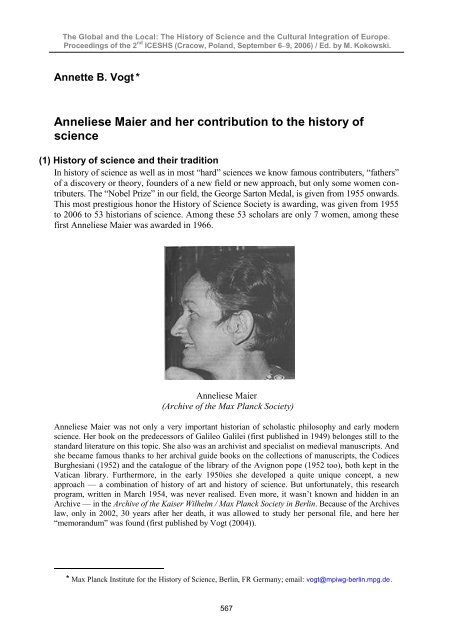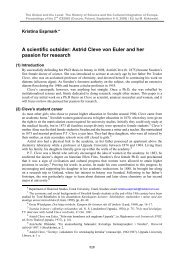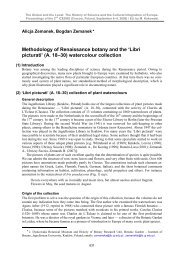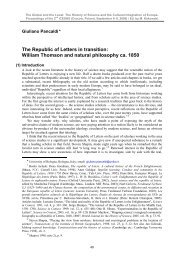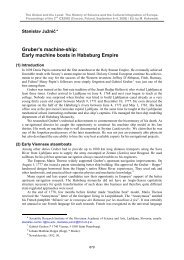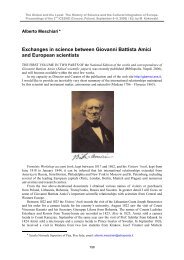Anneliese Maier and her contribution to the history of ... - 2nd ICESHS
Anneliese Maier and her contribution to the history of ... - 2nd ICESHS
Anneliese Maier and her contribution to the history of ... - 2nd ICESHS
You also want an ePaper? Increase the reach of your titles
YUMPU automatically turns print PDFs into web optimized ePapers that Google loves.
The Global <strong>and</strong> <strong>the</strong> Local: The His<strong>to</strong>ry <strong>of</strong> Science <strong>and</strong> <strong>the</strong> Cultural Integration <strong>of</strong> Europe.<br />
Proceedings <strong>of</strong> <strong>the</strong> 2 nd <strong>ICESHS</strong> (Cracow, Pol<strong>and</strong>, September 6–9, 2006) / Ed. by M. Kokowski.<br />
Annette B. Vogt *<br />
<strong>Anneliese</strong> <strong>Maier</strong> <strong>and</strong> <strong>her</strong> <strong>contribution</strong> <strong>to</strong> <strong>the</strong> his<strong>to</strong>ry <strong>of</strong><br />
science<br />
(1) His<strong>to</strong>ry <strong>of</strong> science <strong>and</strong> <strong>the</strong>ir tradition<br />
In his<strong>to</strong>ry <strong>of</strong> science as well as in most ―hard‖ sciences we know famous contributers, ―fat<strong>her</strong>s‖<br />
<strong>of</strong> a discovery or <strong>the</strong>ory, founders <strong>of</strong> a new field or new approach, but only some women contributers.<br />
The ―Nobel Prize‖ in our field, <strong>the</strong> George Sar<strong>to</strong>n Medal, is given from 1955 onwards.<br />
This most prestigious honor <strong>the</strong> His<strong>to</strong>ry <strong>of</strong> Science Society is awarding, was given from 1955<br />
<strong>to</strong> 2006 <strong>to</strong> 53 his<strong>to</strong>rians <strong>of</strong> science. Among <strong>the</strong>se 53 scholars are only 7 women, among <strong>the</strong>se<br />
first <strong>Anneliese</strong> <strong>Maier</strong> was awarded in 1966.<br />
<strong>Anneliese</strong> <strong>Maier</strong><br />
(Archive <strong>of</strong> <strong>the</strong> Max Planck Society)<br />
<strong>Anneliese</strong> <strong>Maier</strong> was not only a very important his<strong>to</strong>rian <strong>of</strong> scholastic philosophy <strong>and</strong> early modern<br />
science. Her book on <strong>the</strong> predecessors <strong>of</strong> Galileo Galilei (first published in 1949) belonges still <strong>to</strong> <strong>the</strong><br />
st<strong>and</strong>ard literature on this <strong>to</strong>pic. She also was an archivist <strong>and</strong> specialist on medieval manuscripts. And<br />
she became famous thanks <strong>to</strong> <strong>her</strong> archival guide books on <strong>the</strong> collections <strong>of</strong> manuscripts, <strong>the</strong> Codices<br />
Burghesiani (1952) <strong>and</strong> <strong>the</strong> catalogue <strong>of</strong> <strong>the</strong> library <strong>of</strong> <strong>the</strong> Avignon pope (1952 <strong>to</strong>o), both kept in <strong>the</strong><br />
Vatican library. Furt<strong>her</strong>more, in <strong>the</strong> early 1950ies she developed a quite unique concept, a new<br />
approach — a combination <strong>of</strong> his<strong>to</strong>ry <strong>of</strong> art <strong>and</strong> his<strong>to</strong>ry <strong>of</strong> science. But unfortunately, this research<br />
program, written in March 1954, was never realised. Even more, it wasn’t known <strong>and</strong> hidden in an<br />
Archive — in <strong>the</strong> Archive <strong>of</strong> <strong>the</strong> Kaiser Wilhelm / Max Planck Society in Berlin. Because <strong>of</strong> <strong>the</strong> Archives<br />
law, only in 2002, 30 years after <strong>her</strong> death, it was allowed <strong>to</strong> study <strong>her</strong> personal file, <strong>and</strong> <strong>her</strong>e <strong>her</strong><br />
―memor<strong>and</strong>um‖ was found (first published by Vogt (2004)).<br />
* Max Planck Institute for <strong>the</strong> His<strong>to</strong>ry <strong>of</strong> Science, Berlin, FR Germany; email: vogt@mpiwg-berlin.mpg.de .<br />
567
CHAPTER 18. / Symposium R-10.<br />
From Maria Sklodowska-Curie <strong>to</strong> <strong>the</strong> 21st century ...<br />
(2) The life <strong>of</strong> <strong>Anneliese</strong> <strong>Maier</strong><br />
<strong>Anneliese</strong> <strong>Maier</strong> was born in an intellectual family, <strong>her</strong> gr<strong>and</strong>fat<strong>her</strong>, Chris<strong>to</strong>p Sigwart (1830–1904), as<br />
well as <strong>her</strong> fat<strong>her</strong>, Heinrich <strong>Maier</strong> (1867–1933), were important philosop<strong>her</strong>s in Germany. Thanks <strong>to</strong><br />
this family background <strong>and</strong> thanks <strong>to</strong> <strong>the</strong> relatively progressive situation for women students <strong>and</strong> first<br />
women scientists in Germany at that time, she wanted <strong>to</strong> become a scholar like <strong>her</strong> fat<strong>her</strong> <strong>and</strong> <strong>her</strong><br />
gr<strong>and</strong>fat<strong>her</strong>. From 1923 (<strong>the</strong> Abitur) until 1930 (<strong>her</strong> doc<strong>to</strong>ral degree at <strong>the</strong> Berlin University) it seemed<br />
<strong>her</strong> dream comes true. After finishing <strong>her</strong> <strong>the</strong>sis she worked on <strong>her</strong> ―Habilitation‖ — <strong>the</strong> necessary<br />
step becoming a ―Privtadozent‖ at a German University. In <strong>the</strong> same time she supported <strong>her</strong> fat<strong>her</strong> as<br />
his private secretary finishing <strong>and</strong> publishing his opus on <strong>the</strong> his<strong>to</strong>ry <strong>of</strong> philosophy.<br />
Then <strong>the</strong> first break happend in <strong>her</strong> life. In January 1933 <strong>the</strong> Nazi’s raised <strong>to</strong> power. They were<br />
strictely against women scientists, at a German University no single woman was allowed <strong>to</strong> become<br />
―Dozent‖ (instead <strong>of</strong> Privatdozent) between 1933 <strong>and</strong> 1938. After <strong>the</strong> death <strong>of</strong> <strong>her</strong> fat<strong>her</strong> <strong>Anneliese</strong> <strong>Maier</strong><br />
realized his wish <strong>and</strong> published <strong>the</strong> last two volumes <strong>of</strong> his Oeuvre posthumously (in 1934 <strong>and</strong> 1935).<br />
Looking for a payed job in science she got an assistant position (―Hilfsarbeiterin‖) in one project <strong>of</strong><br />
<strong>the</strong> Prussian Academy <strong>of</strong> Science in Berlin in 1936. She worked in <strong>the</strong> little research group preparing<br />
<strong>the</strong> Leibniz edition. This was an excellent ―nishe‖ as Margaret Rossiter described it (see Rossiter<br />
(1982)). <strong>Anneliese</strong> <strong>Maier</strong> changed <strong>her</strong> scientific <strong>to</strong>pic from philosophy <strong>to</strong> his<strong>to</strong>ry <strong>of</strong> philosophy. Her<br />
excellent education — she studied philosophy as well as ma<strong>the</strong>matics <strong>and</strong> physics — was a good basis<br />
for this new <strong>to</strong>pic. Furt<strong>her</strong>more, thanks <strong>to</strong> <strong>the</strong> Leibniz edition she had <strong>to</strong> travel <strong>to</strong> Italy, looking for<br />
letters <strong>of</strong> G. W. Leibniz in Italian Archives. In Rome, first she came in contact with <strong>the</strong> Vatican library<br />
<strong>and</strong> <strong>the</strong> famous Biblio<strong>the</strong>ca Hertziana — <strong>the</strong> only Kaiser Wilhelm Institute on art his<strong>to</strong>ry <strong>and</strong> located<br />
outside <strong>of</strong> Germany. Because <strong>of</strong> <strong>her</strong> personal relations — through colleagues <strong>of</strong> <strong>her</strong> fat<strong>her</strong> — she managed<br />
<strong>to</strong> get grants from <strong>the</strong> German Science Foundation (Deutsche Forschungsgemeinschaft) for <strong>her</strong> work in<br />
Rome. In 1938 she finally arrived in Rome, <strong>and</strong> <strong>the</strong> second break happened.<br />
From 1938 until <strong>her</strong> death <strong>Anneliese</strong> <strong>Maier</strong> lived <strong>and</strong> worked in Rome. She became <strong>the</strong> first<br />
woman assistant (in 1943) in <strong>the</strong> Biblio<strong>the</strong>ca Hertziana. Because <strong>of</strong> <strong>the</strong> racist policy <strong>of</strong> <strong>the</strong> Nazi’s <strong>the</strong><br />
Institute was named now Kaiser Wilhelm Institute for Art His<strong>to</strong>ry <strong>and</strong> Cultural Study (KWI). She<br />
established close relations <strong>to</strong> <strong>the</strong> Biblio<strong>the</strong>ca Vaticana. When <strong>the</strong> situation <strong>of</strong> <strong>the</strong> KWI became dramatic<br />
because <strong>of</strong> WW II she moved under <strong>the</strong> umbrella <strong>of</strong> <strong>the</strong> Vatican: she was privately payed by Cardinal<br />
Giovanni Mercati — women were not allowed <strong>to</strong> be employees in <strong>the</strong> Vatican library — for <strong>her</strong><br />
archival work on <strong>the</strong> codices <strong>of</strong> manuscripts which she published in 1952; in 1943 she converted <strong>to</strong><br />
Catholicism. Her accurate study <strong>of</strong> <strong>the</strong> old manuscripts became <strong>the</strong> basis <strong>of</strong> <strong>her</strong> later scientific work on<br />
medieval scholastic philosophy. She became an expert on this field, knowing all relevant sources in<br />
<strong>the</strong> Vatican library.<br />
The third break happend in 1954: <strong>Anneliese</strong> <strong>Maier</strong> was nominated as a Scientific Member <strong>of</strong> <strong>the</strong><br />
Max Planck Society, <strong>the</strong> successor <strong>of</strong> <strong>the</strong> Kaiser Wilhelm Society (comparable with <strong>the</strong> membership in<br />
a German Academy <strong>of</strong> Science). She became an acknowledged expert in his<strong>to</strong>ry <strong>of</strong> medieval philosophy<br />
<strong>and</strong> science. Although she got several honours (including <strong>the</strong> membership in an Academy <strong>of</strong> Science<br />
in Germany), she got no pr<strong>of</strong>essorship in Germany. In <strong>the</strong> Max Planck Institute Biblio<strong>the</strong>ca Hertziana<br />
(as it was re-named) she got not <strong>the</strong> position <strong>of</strong> a head <strong>of</strong> a department because <strong>of</strong> <strong>the</strong> negative votum<br />
<strong>of</strong> <strong>the</strong> direc<strong>to</strong>r Franz von Metternich. She only got financial support from <strong>the</strong> Max Planck Society.<br />
T<strong>her</strong>efore, she played no role as one <strong>of</strong> <strong>the</strong> founders <strong>of</strong> his<strong>to</strong>ry <strong>of</strong> science in <strong>her</strong> native country. But<br />
beeing in Rome all <strong>the</strong> time, she became a men<strong>to</strong>r for many young American his<strong>to</strong>rians <strong>of</strong> sciences.<br />
She also was an advisor for <strong>the</strong> US National Science Foundation.<br />
(3) The work <strong>of</strong> <strong>Anneliese</strong> <strong>Maier</strong><br />
Although born in Germany, <strong>Anneliese</strong> <strong>Maier</strong> became an European his<strong>to</strong>rian <strong>of</strong> science. Because <strong>of</strong> <strong>the</strong><br />
political circumstances in <strong>her</strong> country — <strong>the</strong> Nazi regime — she went <strong>to</strong> Italy, she lived <strong>and</strong> worked<br />
most <strong>of</strong> <strong>her</strong> time in Rome. She published in German, later also in French <strong>and</strong> Italian. Her articles <strong>and</strong><br />
books includes large quotations in Latin — <strong>the</strong> common language <strong>of</strong> scholars <strong>and</strong> scientists from<br />
about <strong>the</strong> 10th century until <strong>the</strong> 19th century. Unfortunately, she never published in English. Plans <strong>to</strong><br />
translate <strong>her</strong> famous books in<strong>to</strong> English were never realized. Thus, Steven D. Sargent from Philadelphia<br />
mentioned in his book:<br />
568
Annette B. Vogt<br />
<strong>Anneliese</strong> <strong>Maier</strong> <strong>and</strong> <strong>her</strong> <strong>contribution</strong> <strong>to</strong> <strong>the</strong> his<strong>to</strong>ry <strong>of</strong> science<br />
<strong>Maier</strong>’s German is very readable, but until <strong>the</strong> student has developed <strong>the</strong> necessary level<br />
<strong>of</strong> pr<strong>of</strong>iciency in <strong>the</strong> language, <strong>Maier</strong>’s studies will literally be a closed book (Sargent<br />
(1982), p.VII).<br />
(4) Her unknown Memor<strong>and</strong>um<br />
The special situation in <strong>the</strong> Biblio<strong>the</strong>ca Hertziana in <strong>the</strong> early 1950s, <strong>the</strong> negotiations getting back this<br />
treasure from <strong>the</strong> Vatican <strong>to</strong> <strong>the</strong> re-opened Kaiser Wilhelm Society as Max Planck Society, <strong>and</strong> <strong>the</strong><br />
antifeministic policy <strong>of</strong> <strong>the</strong> German ―m<strong>and</strong>arines‖ (see Ringer (1983)) until <strong>the</strong> 1960ies were <strong>the</strong><br />
reasons that <strong>Anneliese</strong> <strong>Maier</strong> was nominated as a Scientific Member <strong>of</strong> <strong>the</strong> MPS but never was given<br />
<strong>the</strong> planned department for his<strong>to</strong>ry <strong>of</strong> science <strong>and</strong> art. Her memor<strong>and</strong>um about <strong>the</strong> relations between<br />
art his<strong>to</strong>ry <strong>and</strong> his<strong>to</strong>ry <strong>of</strong> humanity was written at <strong>the</strong> time when this department under <strong>her</strong> leadership<br />
was in discussion. But it was not realised, <strong>the</strong> memor<strong>and</strong>um was given <strong>to</strong> <strong>the</strong> personal file <strong>of</strong> <strong>Anneliese</strong><br />
<strong>Maier</strong> <strong>and</strong> disappeared in <strong>the</strong> Archive (see ―Denkschrift‖, 12.3.1954, in MPA: II, 1A, PA A. <strong>Maier</strong>,<br />
vol.1, copy (8 pp.)).<br />
Today, 60 years later, <strong>the</strong> memor<strong>and</strong>um <strong>of</strong> <strong>Anneliese</strong> <strong>Maier</strong> is a his<strong>to</strong>rical document only. Her<br />
concept, <strong>her</strong> approach, was never realised, <strong>and</strong> in <strong>the</strong> his<strong>to</strong>ry <strong>of</strong> science as well as in <strong>the</strong> his<strong>to</strong>ry <strong>of</strong> art<br />
ot<strong>her</strong> approaches were made <strong>and</strong> realised. But <strong>her</strong> proposals are still interesting:<br />
first, <strong>to</strong> combine his<strong>to</strong>ry <strong>of</strong> science <strong>and</strong> humanities with his<strong>to</strong>ry <strong>of</strong> art on special research <strong>to</strong>pics,<br />
or related <strong>to</strong> special questiones;<br />
second, <strong>to</strong> study accurate, detailled, carefully all manuscripts as a pre-condition for any analysis<br />
<strong>and</strong> conclusions;<br />
third, <strong>to</strong> be carefully with interpretations <strong>and</strong> explanations; not <strong>to</strong> overestimate single facts;<br />
<strong>and</strong> <strong>to</strong> interpretate <strong>the</strong> empirical material (facts) only in <strong>the</strong> context <strong>of</strong> time <strong>and</strong> circumstances.<br />
(5) An <strong>Anneliese</strong>-<strong>Maier</strong>-Prize<br />
Re-evaluating <strong>the</strong> work <strong>of</strong> <strong>Anneliese</strong> <strong>Maier</strong> (independently 2 articles were published, see <strong>Maier</strong>u<br />
(200x) <strong>and</strong> Vogt (2004)), one learns again <strong>her</strong> fascinating knowledge, <strong>her</strong> broad education, <strong>and</strong> <strong>her</strong><br />
underst<strong>and</strong>ing <strong>of</strong> science <strong>and</strong> his<strong>to</strong>ry <strong>of</strong> science, <strong>of</strong> philosophy <strong>and</strong> his<strong>to</strong>ry <strong>of</strong> philosophy. To<br />
remember <strong>her</strong> it would be marvellous <strong>to</strong> establish a prize with <strong>her</strong> name, <strong>and</strong> in <strong>the</strong> frame <strong>of</strong> <strong>the</strong><br />
relatively new European Society for His<strong>to</strong>ry <strong>of</strong> Science (ESHS).<br />
T<strong>her</strong>eore, I would like <strong>to</strong> suggest <strong>to</strong> establish an<br />
<strong>Anneliese</strong> <strong>Maier</strong>-Prize for his<strong>to</strong>ry <strong>of</strong> science <strong>of</strong> <strong>the</strong> ESHS<br />
for <strong>the</strong> best publication in his<strong>to</strong>ry <strong>of</strong> science <strong>of</strong> <strong>the</strong> last two years between <strong>the</strong> conferences <strong>of</strong> <strong>the</strong> ESHS.<br />
<strong>Anneliese</strong> <strong>Maier</strong><br />
* 14.11.1905 in Tübingen (Anna Elisabeth Regine)<br />
―Abitur‖ in 1923 in Heidelberg, 1923–1929 study <strong>of</strong> philosophy, physics <strong>and</strong> ma<strong>the</strong>matics at <strong>the</strong><br />
Berlin University, doc<strong>to</strong>ral <strong>the</strong>sis (30.7.1930) ―Kants Qualitätskategorien‖<br />
1929/30–1935 studies, journeys, private assistant <strong>of</strong> <strong>her</strong> fat<strong>her</strong><br />
1.2.1936–1939 assistant (―Hilfsarbeiterin‖) in <strong>the</strong> research group ―edition <strong>of</strong> G. W. Leibniz‖ <strong>of</strong> <strong>the</strong><br />
Prussian Academy <strong>of</strong> Science<br />
1.1.1938–31.3.1943 with grants <strong>of</strong> <strong>the</strong> German Science Foundation (DFG) in Rome, guest scholar at<br />
<strong>the</strong> Kaiser Wilhelm Institute (KWI) for art <strong>and</strong> cultural studies in <strong>the</strong> Palazzo Zuccari (<strong>the</strong> Biblio<strong>the</strong>ca<br />
Hertziana), 1.4.1943–1944 assistant <strong>and</strong> librarian in this KWI<br />
1944–1950 working for <strong>the</strong> Biblio<strong>the</strong>ca Vaticana (remunerated by cardinal G. Mercati)<br />
since 1950 grants (―Forschungsbeihilfen‖) from <strong>the</strong> Max Planck Society<br />
† 2.12.1971 in Rome<br />
569
CHAPTER 18. / Symposium R-10.<br />
From Maria Sklodowska-Curie <strong>to</strong> <strong>the</strong> 21st century ...<br />
Honors:<br />
1949 Corresponding Member <strong>of</strong> <strong>the</strong> Academy <strong>of</strong> Science in Mainz<br />
1951 title ―Pr<strong>of</strong>essor‖, University Cologne<br />
1954 (14.12.) Scientific Member <strong>of</strong> <strong>the</strong> Max Planck Society<br />
1958 Member <strong>of</strong> <strong>the</strong> Académie International pour l’his<strong>to</strong>ire des Sciences, Paris<br />
1962 Corresponding Member <strong>of</strong> <strong>the</strong> Academy <strong>of</strong> Science in Göttingen<br />
1966 Corresponding Member <strong>of</strong> <strong>the</strong> Bavarian Academy <strong>of</strong> Science in Munich<br />
1966 Sar<strong>to</strong>n Medal (His<strong>to</strong>ry <strong>of</strong> Science Society)<br />
1970 Member <strong>of</strong> <strong>the</strong> Mediaeval Academy <strong>of</strong> America<br />
since 1962 Co-edit. ―Archive for His<strong>to</strong>ry <strong>of</strong> Exact Sciences‖<br />
since 1965 expert for <strong>the</strong> US National Science Foundation<br />
List <strong>of</strong> publications:<br />
Kants Qualitätskategorien. Berlin, 1930 (= doc<strong>to</strong>ral <strong>the</strong>sis)<br />
Die Mechanisierung des Weltbildes im 17. Jahrhundert. Leipzig 1938.<br />
Das Problem der intensiven Größe in der Scholastik. Leipzig 1939 (Kaiser-Wilhelm Institut für<br />
Kunstgeschichte).<br />
Die Impetus<strong>the</strong>orie der Scholastik. Wien 1940 (Kaiser-Wilhelm Institut für Kunstgeschichte).<br />
An der Grenze von Scholastik und Naturwissenschaft. Studien zur Naturphilosophie des 14.<br />
Jahrhunderts. Essen, 1943 (Kaiser-Wilhelm Institut für Kunstgeschichte).<br />
Studien zur Naturphilosopie der Spätscholastik. Roma, ―S<strong>to</strong>ria e Letteratura‖ (5 vol.s):<br />
Die Vorläufer Galileis im 14.Jahrhundert. Roma 1949 (<strong>2nd</strong> edit. 1966; 1977) (St. e L., 22)<br />
Zwei Grundprobleme der scholastischen Naturphilosophie. Das Problem der intensiven Grösse. Die<br />
Impetus<strong>the</strong>orie. Roma 1951 (<strong>2nd</strong> edit.; 3rd edit. 1968) (St. e L., 37)<br />
An der Grenze von Scholastik und Naturwissenschaft. Roma 1952 (<strong>2nd</strong> edit.) (St. e L., 41)<br />
Metaphysische Hintergründe der spätscholastischen Naturphilosophie. Roma 1955 (St. e L., 52)<br />
Zwischen Philosophie und Mechanik. Roma 1958 (St. e L., 69)<br />
Ausgehendes Mittelalter. Gesammelte Aufsätze zur Geistesgeschichte des 14. Jahrhunderts. 3<br />
volumes:<br />
vol.1, Roma 1964 (―S<strong>to</strong>ria e Letteratura‖, 97)<br />
vol.2, Roma 1967 (―S<strong>to</strong>ria e Letteratura‖, 105)<br />
vol.3, Roma 1977 (―S<strong>to</strong>ria e Letteratura‖, 138, Ed. Agostino Paravicini Bagliani)<br />
Zwei Untersuchungen zur nachscholastischen Philosophie. Die Mechanisierung des Weltbildes im 17.<br />
Jahrhundert. Kants Qualitätskategorien. Roma 1968 (<strong>2nd</strong> edit.) (―S<strong>to</strong>ria e Letteratura‖, 112)<br />
Editions <strong>of</strong> sources:<br />
Codices Burghesiani Biblio<strong>the</strong>cae Vaticana. Città del Vaticano 1952 (495 pp.).<br />
Der letzte Katalog der päpstlichen Biblio<strong>the</strong>k von Avignon (1594). Roma 1952 (65 pp.).<br />
Bibliotecae Apos<strong>to</strong>licae Vaticanae codices manu scripti recensiti. Codices Vaticani Latini. Codices<br />
2118–2192. In: Biblio<strong>the</strong>ca Vaticana 1961, pp. X-250.<br />
Der Katalog der päpstlichen Biblio<strong>the</strong>k in Avignon vom Jahr 1411. In: Archivum His<strong>to</strong>riae Pontificiae<br />
1 (1963), pp. 97–177.<br />
Bibliographies:<br />
In: Bagliani (1977, vol.3), pp. 617–626.<br />
In: <strong>Maier</strong>ù (1981), pp. 15–23.<br />
570
Annette B. Vogt<br />
<strong>Anneliese</strong> <strong>Maier</strong> <strong>and</strong> <strong>her</strong> <strong>contribution</strong> <strong>to</strong> <strong>the</strong> his<strong>to</strong>ry <strong>of</strong> science<br />
Obituaries:<br />
Ulmann-Brockhaus, Ot<strong>to</strong>, ―<strong>Anneliese</strong> <strong>Maier</strong>‖, Mitteilungen aus der MPG, 1972, Heft 1, S. 9–11.<br />
Odier, Jeanne Bignami, ―Obituary‖, Revista di S<strong>to</strong>ria della Chiesa in Italia, 20 (1972), pp. 245–248.<br />
Schmaus, M. (Nachruf), Jahrbuch der Bayerischen AdW, 1972, S.250-258.<br />
Grant, E. (Necrologe), Archives Internat. d’Hist. des Sciences, 24 (1974), pp.143–144.<br />
Secondary literature:<br />
Alfonso <strong>Maier</strong>ù (Ed.). Studi sul XIV (trecen<strong>to</strong>) secolo in memoria di <strong>Anneliese</strong> <strong>Maier</strong>. (―S<strong>to</strong>ria e<br />
Letteratura‖, 151; Roma 1981).<br />
On <strong>the</strong> threshold <strong>of</strong> exact science: selected writings <strong>of</strong> <strong>Anneliese</strong> <strong>Maier</strong> on late medieval natural<br />
philosophy. Ed. Steven D. Sargent (Philadelphia: Univ. <strong>of</strong> Pennsylvania Press,1982).<br />
Vogt, Annette, ―Von Berlin nach Rom - <strong>Anneliese</strong> <strong>Maier</strong> (1905-1971)‖, in: Walt<strong>her</strong>, Peter Th., Schalenberg,<br />
Marc (eds.), ―... immer im Forschen bleiben―, Rüdiger vom Bruch zum 60. Geburtstag,(München:<br />
Franz Steiner 2004), pp. 391-414; <strong>the</strong> memor<strong>and</strong>um pp. 408-414.<br />
571


